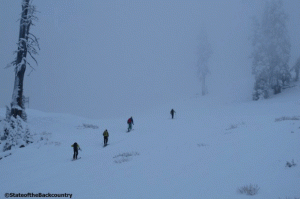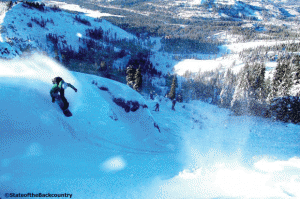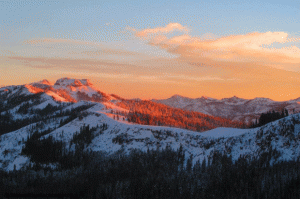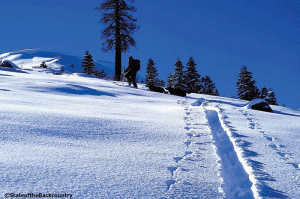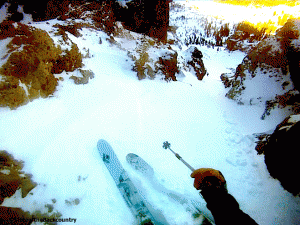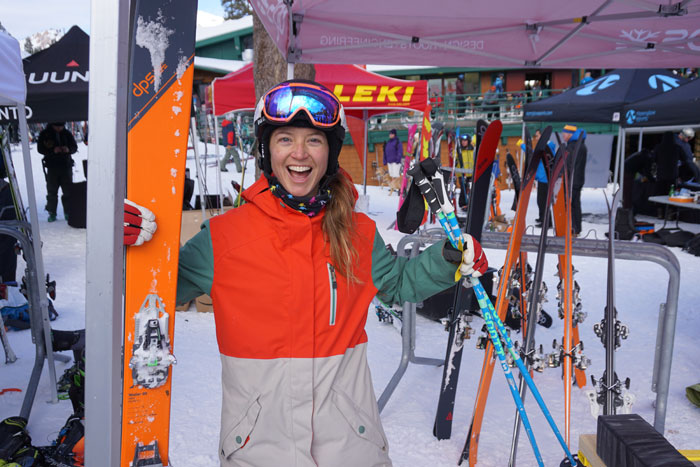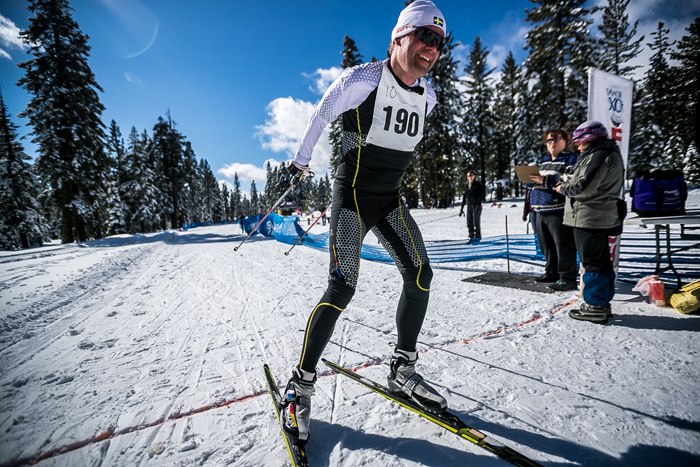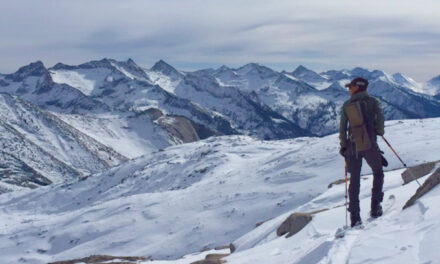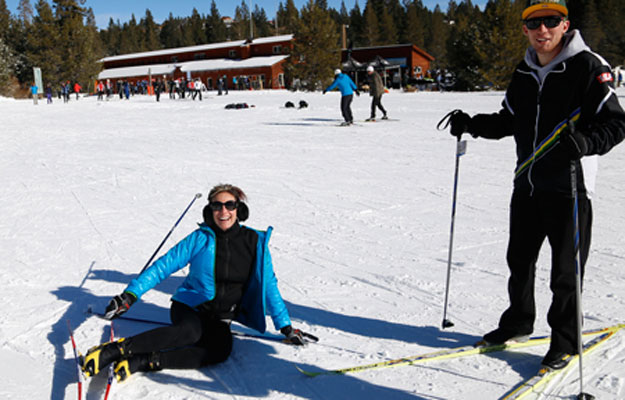- Tahoe’s Nevada Beach Tops the List of Hard-to-Book Campgrounds - 07/17/2024
- Cannabis Watershed Protection Program Cleans Up Illegal Grow Sites - 07/10/2024
- French Fire - 07/05/2024
Your best bet for Tahoe Backcountry
Words and Photos by Brennan Lagasse
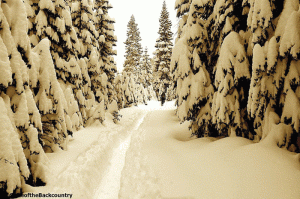
Jillian Raymond enjoys a winter wonderland on her way to scoring early season powder off Donner Pass.
What winter loving Californian doesn’t want to get out and stretch their legs a bit, tap into a snowcentric workout, and take in some world-class views? Yes there’s global weirding and the Sierra Nevada is currently grinding out its third poor winter in a row, and no matter if you live in or near the mountains, everyone’s getting a little stir crazy. But that doesn’t mean you have to give into the gloom and doom of the latest climate models.
Being a member of the backcountry skiing community is all about working with what’s available. This winter season, to get a good snow workout with skins or snowshoes you’re going to have to be resourceful. An adventurous attitude will go a long ways, too.
Donner Pass has long been a special place for snow-lovers from the Golden State. With the current drought, it also happens to be one of the few places where you can truly piece together some quality time in high elevation terrain with skiable snow.
While the high elevation access points in the Northern Sierra and greater Lake Tahoe region are normally the go-to’s for early and late season backcountry skiing – including lean snow years – classic spots like Carson Pass and the Mt. Rose area have not fared quite as well as Donner Pass this season. I’m certainly not saying the Donner area is ideal. In fact, all skiers need to be hyperaware of thin cover, hidden obstacles and all the other dangers that come with a shallow snowpack in the backcountry. What makes Donner your best bet is that it boasts two main zones and a new inbounds touring program worth checking out while we continue waiting for the snow fall in 2014.
Whether you check out accessible backcountry skiing via Sugar Bowl and Anderson Ridge, or head across the street to Castle Peak, remember that in the Sierra all it takes is one big storm to change everything. In the meantime, a little shortness of breath on the skin track, combined with a couple of turns and a mountain vista or two is chicken soup for your soul. These three Donner options will help you make the most of what’s currently available.
The Sugar Bowl Uphill Ski Pass
New for this winter is the Sugar Bowl uphill ski pass. The adjacent terrain to the Sugar Bowl ski area boundary has always been some of the best in the region. Now with the uphill pass ski tourers are welcome to skin up into the ski resort’s boundary and head out to the adjoining backcountry.
All you have to do is stop into Sugar Bowl’s special tickets, sign a waiver, and they’ll set you up with a free uphill pass if you already have a season pass or charge you $149 if not. You’ll need to take a picture and wear an armband while skinning inbounds. The process takes a few minutes and is arguably the most progressive of its kind in the state. Of course you can also access nearby backcountry skiing from a few various locales away from Sugar Bowl, but this season, the higher you start the better, and Sugar Bowl’s new policy will help you start and end your adventure on snow rather than dirt.
Anderson Ridge
This meandering gem starts behind Sugar Bowl’s Mt. Lincoln and extends south to Mt. Anderson (elev. 8,683’), high atop the Sierra Crest. Mt. Anderson is a worthy backcountry ski tour on its own, but the north facing terrain that’s accessible from the Sugar Bowl boundary to the peak itself, and the terrain that stretches south from there towards Squaw Valley, is where a vast majority of the most skiable terrain in the greater Northern Sierra is currently located.
Anderson Ridge holds a wide diversity of terrain choices depending on what one’s comfortable with, with ridge access coming directly from the Pacific Crest Trail (PCT). If you want to ensure you’re skinning and skiing as much as possible this season, you might want to consider hiking from one of the canyons that access this section of the Sierra Crest such as Cold Stream Canyon to the north, or Deep Creek and Pole Creek accessed via Highway 89 to the south. Otherwise, even in the deepest of winters, expect Anderson Ridge to be bone dry due to wind and sun exposure.
Anderson Peak is also well known for being home to one of the four revered Sierra Club huts in the region. The Benson Hut (elev. 8,350’) is one of the only huts where you can wake up and drop right into a ski run, rather than starting your day on a skintrack. It’s a quaint shelter found at the base of the peak that frames gorgeous views and quality ski terrain. In this sparse winter it may be just the place to spend an evening recharging your batteries in the high country.
Castle Peak
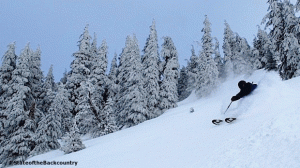
This photo shows the northwest trees of Castle Peak in prime shape after Tahoe’s one big storm in December, 2013. Photo: Jillian Raymond, Skier: Brennan Lagasse
One of the classic peaks in the Northern Sierra, Castle Peak (elev. 9,103’) catches everyone’s eye while driving the I-80 corridor over Donner Pass. While the south facing aspects offer exceptional corn skiing, there isn’t much of any south facing snow to work with this season. The northwest aspect offers a better option.
Castle Peak offers a reasonable approach to its northwest trees, but it’s a hike. Once Castle Pass is reached, various options ranging from a few hundred vertical feet to just over a thousand vertical feet of moderate tree skiing is attainable. The northwest trees often hold good snow for long periods of time and at the base of the trees is another famed Sierra Club hut. The Peter Grubb Hut is found after the two- mile skin into Castle Pass, followed by
a 250 vertical foot run down into Round Valley. The hut had been recently closed for renovations, but is now officially open for 2014.
Heading back south from Castle Pass more ski opportunities can be found on Andesite Ridge, and for the more adventurous, the backside of Castle Peak awaits. These northern swaths keep snow intact for long periods of time, but are also commonly rocky when low snow is in play throughout the greater area. Your best bet for a nice long skin, quality views and a few turns are to head towards the Peter Grubb hut and up the northwest trees, but if your skill set and mentality are prime enough, you might want to peek over the edge at the top and give the northern reaches a look.
Brennan Lagasse is a writer, teacher, ski guide, athlete and photographer. You can check out more of Brennan’s work at www.stateofthebackcountry.com and at facebook.com/stateofthebackcountry


